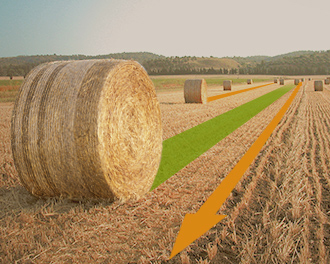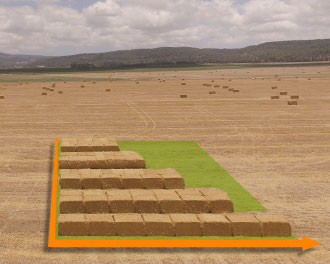What’s the True Cost of a Bale? Best Practice for Pricing Your Baling Services
2025
Every bale you make has a cost attached to it, whether you’re a contractor pricing jobs for the season, or… Read more
Every bale you make has a cost attached to it, whether you’re a contractor pricing jobs for the season, or a farmer working out your own forage costs. But working out the “true cost” of a bale isn’t always straightforward.
Too often, people underestimate expenses or forget to include hidden costs. And when margins are tight, getting this wrong can mean the difference between profit and loss.
Here, we’ll break down the key costs you need to factor into your calculations, and highlight why using premium netwrap is not a luxury, but a smart investment.
- Core Input Costs
When you’re working out the cost per bale, start with the essentials.
- Netwrap: Every bale needs netwrap, so calculate how many bales you get from a roll, and the cost per bale. Don’t just look at the roll price, the quality matters (more on that later).
- Stretchfilm (if wrapping silage): Again, cost this out per bale, based on the number of layers you apply.
- Twine (if relevant): For certain jobs, twine will also be part of the calculation.
These are the obvious costs, but they’re only part of the picture.
- Machinery Costs
Your baler isn’t running for free. To get a realistic price per bale, factor in:
- Depreciation: Spread the cost of your baler, wrapper, and tractor over their working life.
- Fuel: Consumption varies by crop and density, but fuel is a significant expense.
- Maintenance & repairs: Belts, bearings, knives, and net systems all wear over time. Budget realistically, repairs are inevitable.
- Finance: Extras fitted to machines (even those not strictly necessary) increase both the machine’s purchase price and the cost of finance packages. This pushes up repayments and inflates your true cost per bale, so think carefully before adding optional features you don’t really need.
- Labour
Your time (or your team’s time) is one of the biggest costs. Factor in:
- Operator wages: Whether it’s your own labour or an employee’s, put a fair hourly rate against the hours worked.
- Efficiency: Premium products that reduce stoppages (like reliable netwrap) help keep labour costs down by increasing bales per hour. The importance of this cannot be stressed enough, labour costs for re-baling, fixing broken net etc can mount up fast and result in a very expensive cost per bale.
- Logistics & Handling
Often overlooked, but important:
- Transport: Fuel and time moving bales from field to yard.
- Loading/unloading: Machinery wear and operator time add up.
- Storage losses: Poorly wrapped bales mean more waste and these losses can result in additional cost, purchasing replacements or, if you are a contractor, potentially covering the loss.
- The Hidden Costs of Cheap Netwrap
It’s tempting to save a few pounds on cheaper netwrap, but here’s where it often backfires:
- Breakages & re-baling: If net tears, splits, or fails, you lose time and money re-baling.
- Bales falling apart in handling: Nothing hurts a contractor’s reputation faster than bales that collapse during stacking or transport.
- Shorter rolls: Some “value” rolls are shorter than advertised, meaning fewer bales per roll, and fewer jobs done before a changeover.
- Crop losses: Exposed shoulders or loose wraps lead to spoilage, and lost feed value.
In short: what looks like a saving per roll often ends up costing far more across a season.
- Calculating Price per Bale
A simple framework is:
(Netwrap or Twine + Film) + (Fuel + Labour + Maintenance + Depreciation + Finance) + (Handling + Transport + Storage costs) ÷ Number of bales produced
This gives you a realistic “true cost” per bale. From there, contractors can set a price that covers costs and delivers profit, while farmers can compare their own cost of production against contractor rates.
- Why Premium Netwrap Pays
Premium netwrap isn’t about spending more, it’s about protecting your margins:
- Consistent roll length = predictable cost per bale.
- Stronger, more reliable performance = fewer breakdowns and stoppages.
- Edge-to-edge coverage = reduced spoilage and storage losses.
- Time saved = more bales per hour, lower labour and fuel costs.
- Dedicated, experienced support = With Tama, you’re not just buying netwrap, you’re backed by a team who are on hand to visit you in the field, troubleshoot issues, and resolve problems quickly, helping minimise downtime during the busiest part of the season.
In short: premium netwrap delivers security, efficiency, and bale quality that protects both your bottom line and your reputation.
Conclusion: Know Your Costs, Protect Your Profit
Whether you’re a contractor setting rates for the season, or a farmer managing forage costs, knowing the true cost of a bale is essential.
Cutting corners with cheaper netwrap might look attractive upfront, but the hidden costs (from re-baling to feed losses) can quickly erode profit.
The smart approach is to calculate carefully, cost realistically, and invest in premium netwrap to protect both your forage and your reputation.



